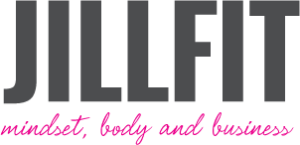Most posts at JillFit are about fat loss. We do metabolic weight workouts, manage carb intake and sprint real fast. But what about for those who want to build muscle? You’ll have to take a slightly different approach.
We use the SCORCH Model:
S = Slow Down Your Weight Workouts
Metabolic conditioning workouts are great for fat loss and can help maintain muscle, but if you want to build, you’ll need to move a little slower, take longer rests so that you can go heavier and add a few more exercises. You shouldn’t necessarily be breathless the entire time during your weight workouts. Focus more on the heaviness and the burning.
C = Concentrate On Each Muscle Separately
Ask any bodybuilder (arguably the ideal practitioners of hypertrophy), and they will say each muscle group needs individual attention. Complexes and hybrid movements are great to use every once in a while, but if you’re serious about adding size, it’s recommended you break up your body parts more. Here’s a split I really like:
Day 1: Chest/Triceps
Day 2: Legs (Quad/glute focus)
Day 3: Off
Day 4: Back/Biceps
Day 5: Legs (Hamstrings/calves/low back focus)
Day 6: Shoulders/Abs
Day 7: Off
O = Overload The Muscles By Upping Weight & Volume
You can’t make gains without progressively overloading the muscle you’re working. This means using a moderately heavy weight and doing a high-volume workout. Pick up dem heavy weights ladies! I always say that most women can lift at least 5 lbs more than they think they can. Maybe even 10. Try it!
I also increase volume by doing 4-5 sets of each exercise, 3-4 exercises per body part, in the rep range of 8-12. This makes for a lot of reps :) Start with a 15-rep max, and progressively add weight over the span of 4-8 weeks, using the same exercises. Then choose new ones.
R = Recovery
You do your growing during your recovery time, so I’d skip doing the same muscle group twice in the same week if you can help it. The small tears you make in the muscle need downtime to grow back stronger and bigger. Recovery also includes getting plenty of sleep, practicing clean nutrition with enough carbs and protein to help rebuild and not doing tons of cardio every day.
C = Carbs And Calories
Nutrition is a huge component in muscle building, obviously. First of all, protein is certainly important, as muscle itself is made up of amino acids. Try to hit 1g protein per pound of body weight, and choose lean sources, including grass-fed beef if possible to get the carni-nutrients so important in muscle building.
Next, enough calories are needed to provide a sufficient quantity of building blocks needed for the metabolism and a surplus to build beyond current levels. And carbs are the wild card. The amount of carbs one consumes is often the difference between building muscle or not. Carbs, especially post-workout, are important to bring up insulin levels in the blood, which play a key stimulatory role in the muscle-synthesis process. Insulin needs to be present in order to build muscle. If you are doing less carbs, be sure to take 5-10g BCAAs post-workout, as they also raise insulin and can act in a similar fashion.
My quick & dirty rule for carbs: If you want to build, start by multiplying your weight in pounds by 1.5 and eat that many grams of carbs (includes both starch and veggies) on days you train. On non-training days, cut this in half. PLEASE don’t stress about counting grams! This does not need to be exact! A serving of starch (like 1/2 cup of dry oats or 1/4 cup dry rice) is around 30g. Eye-ball it. Eat as many grams from veggies (both fibrous and starchy) to get the vitamins and minerals that are necessary for optimal metabolic function, like B vitamins.
H = High-Intensity OR Low-Low Intensity Cardio
IF you are intent on doing cardio, make sure it is either high intensity, short duration like Tabata intervals or track sprints OR very low intensity like leisure walking. High-intensity intervals (20 min or less) hold onto muscle because they spike growth hormone when they push us above the anaerobic threshold, and minimize any spike in cortisol.
Likewise, low-intensity walking or yoga/tai chi can have a profound restorative effect on the body, and lower cortisol (a muscle(and fat)-wasting hormone). If you’re going to cardio it up, I’d suggest keeping it to 3x/week max. For best results, do restorative, low intensity walking only.
That’s it! Best of luck, let me know how you do! :) ox, Jill


